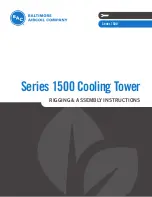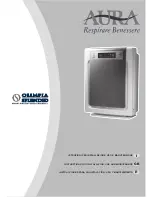
2
Operating the unit in a structure that is not complete (either
as part of new construction or renovation) will void the war-
ranty.
Refer to the unit Specification Sheet for the recommended
indoor model selection.
NOTE:
This unit must be used with a
purchased single stage room thermostat with 24 VAC control
circuitry.
Installation Clearances
This unit is designed for outdoor installations only. Special
consideration must be given to location of the condensing
unit(s) in regard to structures, obstructions, other units, and
any/all other factors that may interfere with air circulation.
Where possible, the top of the unit should be completely un-
obstructed; however, if vertical conditions require placement
beneath an obstruction
there should be a minimum of 60
inches between the top of the unit and the obstruction(s).
The specified dimensions meet requirements for air circula-
tion only. Consult all appropriate regulatory codes prior to de-
termining final clearances.
Another important consideration in selecting a location for the
unit(s) is the angle to obstructions. Either side adjacent the
valves can be placed toward the structure provided the side
away from the structure maintains minimum service clear-
ance. Corner installations are strongly discouraged.
12"
12"
12"
60"
24"
This unit can be located at ground floor level or on flat roofs.
At ground floor level, the unit must be on a solid, level foun-
dation that will not shift or settle. To reduce the possibility of
sound transmission, the foundation slab should not be in con-
tact with or be an integral part of the building foundation. The
foundation slab should be a minimum of 6” wider than the
unit in all directions. Ensure the foundation is sufficient to sup-
port the unit. A concrete slab raised above ground level pro-
vides a suitable base.
The selected site should be no greater than 50’ below or 70’
above the evaporator section. For optimum performance, the
minimum length interconnecting tubing is preferred. When
possible minimize the amount of bends and turns.
Rooftop Installations
If it is necessary to install this unit on a roof structure, ensure
the roof structure can support the weight and that proper
consideration is given to the weather-tight integrity of the roof.
Since the unit can vibrate during operation, sound vibration
transmission should be considered when installing the unit.
Vibration absorbing pads or springs can be installed between
the condensing unit legs or frame and the roof mounting as-
sembly to reduce noise vibration.
NOTE:
These units require special location consideration in
areas of heavy snow accumulation and/or areas with
prolonged continuous subfreezing temperatures. Heat pump
unit bases have cutouts under the outdoor coil that permit
drainage of frost accumulation. Situate the unit to permit free
unobstructed drainage of the defrost water and ice. A
minimum 3" clearance under the outdoor coil is required in
the milder climates.
In more severe weather locations, it is recommended that
the unit be elevated to allow unobstructed drainage and air
flow. The following elevation minimums are recommended:
Rigging
To avoid possible injury or death, all panels must be
in position and secured before lifting this equipment
Use field-supplied spreader bars when lifting the unit to mini-
mize the possibility of lifting cable/straps damage. To pro-
tect the cabinet louvers, use protective material such as ply-
wood behind the cable/straps. Arrange the straps to form a
central suspension point.
NOTE:
When raising and setting
the unit, observe all safety rules. Remove shipping skid and
all protection and lifting material after the unit is in place.










































